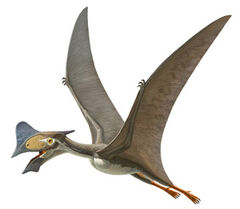| Tapejara | |
|---|---|

| |
| A restoration of Tapejara wellnhoferi | |
| Scientific classification | |
| Kingdom: | Animalia |
| Phylum: | Chordata |
| Class: | Reptilia |
| Order: | †Pterosauria |
| Suborder: | †Pterodactyloidea |
| Family: | †Tapejaridae |
| Subfamily: | †Tapejarinae |
| Genus: | †Tapejara Kellner, 1989 |
| Species: | †T. wellnhoferi |
| Binomial name | |
| †Tapejara wellnhoferi Kellner, 1989 | |

Tapejara (from a Tupi word meaning "the old being") is a genus of Brazilian pterosaur from the Cretaceous Period (Santana Formation, dating to about 108 Ma ago). Tapejara crests consisted of a semicircular crest over the snout, and a bony prong which extended back behind the head.
Species and classification[]
The type species and only one currently recognized as valid by most researchers, T. wellnhoferi, is the smallest species to have been assigned to Tapejara and does not preserve evidence of soft-tissue crest extensions. The specific name honours German paleontologist Peter Wellnhofer. A second species, originally named Tapejara imperator ("emperor"), is much larger and possessed a crest made up of distinctively long prongs, projecting from the rounded snout crest and the back of the skull, which supported a large, possibly rounded sail-like crest of keratin. A third species, Tapejara navigans ("sailing"), was mid-sized and sported a similar crest to T. imperator, though narrower and more dome-shaped, that lacked the backwards-pointing bony support prong.
Several studies in 2007 showed that T. imperator and T. navigans are too different from T. wellnhoferi and therefore require their own genus names. The species T. imperator was given its own genus, Tupandactylus, by Kellner and Campos.[1] Unwin and Martill found that T. imperator and T. navigans belong in the same genus, and named them Ingridia imperator and I. navigans, respectively. The genus name honoured Wellnhofer's late wife Ingrid.[2] Because Tupandactylus was named first, it retains priority over the name Ingridia. To complicate matters, both the name Tupandactylus and Ingridia used the former Tapejara imperator as their type species.[3] The scientists who described Tupandactylus did not name a Tupandactylus navigans (but instead suggested it was synonymous to Tupandactylus imperator), and Tapejara navigans was not formally reclassified as a distinct species of Tupandactylus until 2011.[4]
The cladogram below follows the 2011 analysis of Felipe Pinheiro and colleagues.[4]
| Azhdarchoidea |
| |||||||||||||||||||||||||||||||||||||||||||||||||||||||||||||||||||||||||||
Paleobiology[]
Comparisons between the scleral rings of Tapejara and modern birds and reptiles suggest that it may have been cathemeral, active throughout the day at short intervals. Given the locomotion of other pterosaurs, Tapejara is easily assumed to have taken a quadrupedal, cocodile-like stance when landed, walking in a similar manner. The creature most likely vaulted itself into the air with its strong frontal limbs, and from there was able to assume proper flight. [5]
In popular culture[]

- Tapejara made it's first Media appearance in BBC'S Documentary Walking with Dinosaurs Ep.4 Giant of the Skies.
- Tapejara also made it's IMAX Screen appearance in The National Geographic Documentary Film Flying Monsters.
- Tupandactylus is playable in Primal Carnage Extinction.
- Tapejara appears in the first person shooter game Carnivores Cityscape, where Tapejara can fly around the skies, and can be shot, but pose no threat. They nest in the power generator. It is about the same size as Pteranodon and larger than include a trapezoidal crest, two large wings, and an oddly shaped beak. The species in the game is Tapejara imperator, which has recently been reclassified under its own genus called Tupandactylus. However, at the time of the game's release this creature was considered a species of Tapejara.
- Tapejara is one of the creatures available in the IOS application Jurassic Park Builder, it was released for the first time on November 14th 2014. It appears to be based on Tapejara navigans, which is now considered a species of Tupandactylus. Despite being a carnivorous pterosaur in the game, they get an enclosure without fences like what the herbivores in the game get and may have been a herbivore.
- Tapejara is featured in Dinosaur King.
- Tapejara appears in Jurassic World: The Game as a Rare pterosaur and costs 670 DNA after being hatched for the first time. In Jurassic World: The Game, Tapejara had teeth in its beak while it had no teeth in reality. Like in Jurassic Park: Builder, it seems to be based off of Tupandactylus, which also had no teeth in reality.
- A white colored Tapejara appears in Power Rangers Dino Charge as number 19 also known as the Dino Squash Charger.
- In Dino Ranch, Miguel and Tango get partnered with a Tapejara named Twister.
- Tapejara is one of the creatures that appear in ARK: Survival Evolved.
Gallery[]
Tapejara/Gallery
- ↑ Kellner, A.W.A. (2007). "Short note on the ingroup relationships of the Tapejaridae (Pterosauria, Pterodactyloidea". Boletim do Museu Nacional 75: 1–14.
- ↑ Unwin, D. M. and Martill, D. M. (2007). "Pterosaurs of the Crato Formation." In Martill, D. M., Bechly, G. and Loveridge, R. F. (eds), The Crato Fossil Beds of Brazil: Window into an Ancient World. Cambridge University Press (Cambridge), pp. 475-524.
- ↑ Naish, D. (2008). "Crato Formation fossils and the new tapejarids." Weblog entry. Tetrapod Zoology. 18 January 2008. Accessed 31 January 2008 (http://scienceblogs.com/tetrapodzoology/2008/01/crato_formation_tapejarids.php).
- ↑ 4.0 4.1 Pinheiro, F.L., Fortier, D.C., Schultz, C.L., De Andrade, J.A.F.G. and Bantim, R.A.M. (in press). "New information on Tupandactylus imperator, with comments on the relationships of Tapejaridae (Pterosauria)." Acta Palaeontologica Polonica, in press, available online 03 Jan 2011. doi:10.4202/app.2010.0057
- ↑ Schmitz, L.; Motani, R. (2011). "Nocturnality in Dinosaurs Inferred from Scleral Ring and Orbit Morphology". Science 332 (6030): 705–8. DOI:10.1126/science.1200043. PMID 21493820.